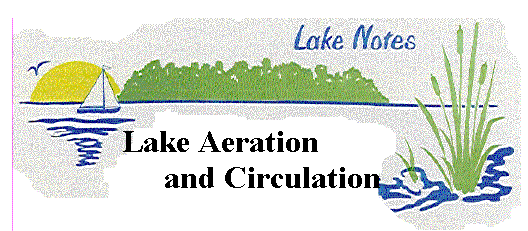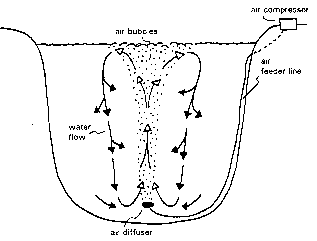|
|
|
|
The purpose of aeration in lake management is to increase the dissolved oxygen content of the water. Various systems are available to help do this—by either injecting air, mechanically mixing or agitating the water, or even injecting pure oxygen. Aeration can increase fish and other aquatic animal habitat, prevent fishkills. and improve the quality of domestic and industrial water supplies and decrease treatment costs. In some cases, nuisance algal blooms can be reduced or a shift to less objectionable algae species can occur. However, aeration can he misused. It is not a "cure-all” for a lake’s ills. It’s important to understand what aeration can and can’t do for your lake so our don’t end up with unexpected or unwanted results—and possibly a waste of money. This issue in the Lake Notes series focuses on artificial circulation as a lake aeration technique. We’ll explore its applicability, potential consequences. and other factors to be considered before deciding to invest in an artificial circulation system—or in reevaluating the system you already have in place. Artificial Circulation Systems Lakes get much of their oxygen from the atmosphere through a process called diffusion. Artificial circulation increases a lake’s oxygen by forcefully circulating the water to expose more of it to the atmosphere. Proper choice and design of an artificial circulation system depends on your lake management goals and the lake’s physical characteristics. Destratifiers Destratification is a type of artificial circulation that completely mixes a stratified lake’s waters from top to bottom and thereby eliminates or prevents summer stratification (the division of a lake into water layers of different temperatures). Two techniques are most common: air injection and mechanical mixing. Air Injection (Diffuser) Systems are the most common destratification method. A compressor on shore delivers air through lines connected to a perforated
pipe(s) or other simple diffuser(s) placed near the bottom, typically in the deep area of the lake. The rising air bubbles cause water in the hypolimnion (the cold. bottom water layer) to also rise, pulling this water into the epilimnion (warm, surface water layer). When the colder, hypolimnetic water reaches the lake
surface, it flows across the surface and eventually
sinks, mixing with the warmer epilimnetic water. If the
system
is adequately powered and enough air is injected, this process continues and the metalimnion
(transition zone between the epilimnion
and hypolimnion) is
broken down. Eventually, the entire lake
becomes of nearly equal temperature with
oxygen
distributed throughout. Many people are surprised to learn that the majority of oxygenation occurs through
the water’s contact with the atmosphere; relatively
little oxygen increase occurs through direct diffusion
from the bubbles. This aeration technique is sometimes referred to as the air-lift
method of circulation, since bottom waters are
"lifted" to the lake surface through the action of the injected
air. |
|

